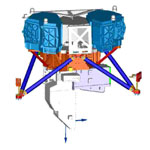MIRI
MIRI (Mid InfraRed Instrument) is an infrared camera and spectrometer for the James Webb Space Telescope (JWST). It will operate between wavelengths of 5 to 27 microns, a region which is difficult or impossible to observe from the ground.
MIRI will have three advantages over other infrared instruments. Firstly, its location in space will remove the blocking and large background noise effects of the atmosphere which limit ground-based telescopes. Secondly, JWST can be cooled to a very low temperature, reducing the emission from the telescope and greatly improving its sensitivity. Thirdly, the JWST will have a far larger mirror then any other infrared space telescope, giving improved angular resolution.
MIRI is crucial for the JWST science programme which includes goals such as detecting the first episode of star formation, determining the formation history of galaxies, clarifying the processes of star and planet formation, seeking out new planets that can later be investigated for their potential to support life.
The UK ATC will be responsible for designing and building a spectrometer pre-optics module containing a set of four image slicers. Image slicers are a relatively new technology which enable the study of spatial and spectral information simultaneously. The image slicers will be based on ones developed at the UK ATC for UIST, and require the further development of existing technology for use in the long wavelength region.
MIRI is one of three instruments on the James Webb Space Telescope (JWST) and will provide imaging, spectroscopy and coronagraphy at wavelengths of 5 to 28 µm.
MIRI is an international project combining the talents of a consortium of European partners, including the UK ATC, the European Space Agency, and an international science team with those of scientists and engineers at the Jet Propulsion Laboratory.
The current plan is for a launch date of 2014.
Information about MIRI can also be found on the ESA, NASA JWST and MIRI European Consortium websites
